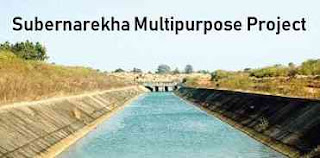Subernarekha Multipurpose Project (SMP) is one of the multipurpose projects in eastern India. Subernarekha River flows through the highly industrialized areas of the states of Jharkhand, West Bengal, and Odisha. Apart from irrigation, vast quantities of water are used by industries and towns in the Subernarekha basin. Ranchi and Jamshedpur are the most important cities in the Subernarekha basin. A Tripartite Agreement to this effect (TPA) was concluded between the Chief Ministers of Bihar (before the formation of the Jharkhand State), West Bengal and Orissa at New Delhi on 7.8.1978.
Subernarekha Multipurpose Project
The Subernarekha Multipurpose Project system comprises of:- Subernarekha Multipurpose Project (SMP), Phases I and II (Jharkhand)
- Subernarekha Irrigation Project (SIP), Odisha
- Subernarekha Barrage-cum-Dolong Dam Project (SBDP), West Bengal.
For Odisha and West Bengal to use their share of water separate projects have been approved ( Subernarekha irrigation Project Odisha, Subernarekha Barrage Project West Bengal). In this project Odisha shares, cost of Icha dam, Galudih barrage, and common canal off taking from Galudih barrage for storage & diversion of water for irrigation purpose and also Chandil dam for its storage of water for flood control as per TPA agreement dated 7/8/1978. West Bengal also shares cost in Chandil dam for its storage of water for irrigation as well as flood control, to be used from Subernarekha barrage located in its state.
Two Dams
1. Chandil Dam
2. Icha Dam (Kharkhai River)
The proposed Icha Dam will be the second biggest dam after Chandil Dam with Gross Storage Capacity of 1048 Mm³ and Full Reservoir Level of 174.65 m. The dam will be loacted at Icha, West Singhbhum District, Jharkhand. The government of India has recently declared ‘Icha Dam’, on the River ‘Kharkai’, as a national project under ‘Accelerated Irrigation Benefit Programme (AIBP)’. However, the construction is strongly opposed by the tribal community and refused to give consent for land acquisition to construct Icha dam. After the completion of the construction, the dam will affect about 87 villages in Jharkhand (26 villages are likely to be fully submerged and 61 villages would be partially submerged) and 36 villages in Odisha).
Two Barrages
1. Kharkai Barrage
Kharkai barrage is located at Ganjia, Gamharia, District: Seraikela-Kharsawan of Jharkhand. It is 258 m long barrage across river Kharkai. The project is under construction and it will divert water of river Kharkai to Kharkai Right and Left bank canals for irrigation, industrial and municipal use.
2. Galudih Barrage
Galudih is a small hilly town in East Singhbhum District of the state Jharkhand. The 436.20 m. long barrage on main stream of Subernarekha river, downstream of its confluence with Kharkai, a tributary of Subernarekha, operates in conjunction with Icha and Chandil dam control structures, diverting water in Galudih Right Bank canal and Galudih Left Bank canal. Galudih Right Main Canal to feed mainly to Odisha.
Canal Systems
- Chandil Left & Right Main Canal and Distribution System
- Galudih Right & Left Main Canal
- Icha Left and Right Main Canal
- Kharkai Left & Right Main Canal
The main objectives of Subernarekha Multipurpose Project (SMP) are
- To provide reliable water supply to agricultural lands
- To provide water supply for industrial uses.
- To reduce flood damage in Odisha and West Bengal
- To generate hydroelectric power through medium, mini and micro-hydroelectric projects
Controversy
For the project purpose land was acquired from local inhabitants, and construction started in 1982-83. However, the project works stopped in many occasion due to the opposition to land acquisition by the land owners. Also, forest clearance was not granted because the project is located in the forest areas. There were also complains of corruption and the lack of funds. The agitations by the land owners started since 1972, when the project was initially conceptualized. In January, 1979 thousands of tribal, hold protest demonstration at the Chandil Dam site. Police fired bullets to the agitating protesters resulted to deaths of four individuals. Since then, villagers are repeatedly protesting for rehabilitation and compensation to the concerned authorities.
About 52 villages are submerged every year during the monsoon, when the water level of the Chandil Dam rises. Generally, villagers are relocated in temporary makeshift arrangements. Local administration sometimes posted notices in villages likely to be submerged during the monsoons.


